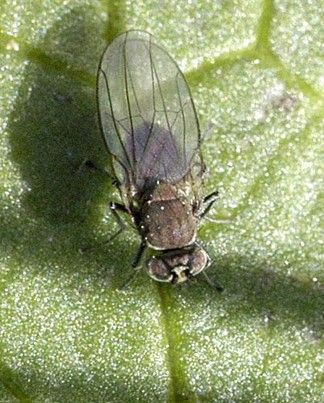Monumental Questions - Wilbur Hot Springs Has its own Species of Fly?

You might know that Mono Lake has its own species of brine fly but did you know that the Berryessa Snow Mountain National Monument region has one as well?
Brine flies, also called shore flies or alkali flies, are minute fly species that belong to the Ephydridae family. These teeny flies measure from less than a millimeter to about seven millimeters in length and are usually brown, gray or black with large wings relative to the length of the body. There are 2000 species worldwide with 144 genera and can be found along the shores of both the ocean as well as inland water such as those found in California’s Mono Lake, The Great Salt Lake in Utah and Abert Lake in Oregon. Most species are diurnal and when adults are present, can be seen in enormous quantities forming dense mats around the edges of ponds, streams and shorelines. Although these dark swarms of tiny flies may look intimidating, they really don’t want anything to do with humans or any species other than their own because as adults, they only live a few days - just long enough to reproduce.
Most of the members of this family are primarily aquatic, spending most of their lives underwater and only emerging as adults to reproduce. Adults of different species can be identified by range and habitat as well as wing shape and size, wing vein pattern and color; some larvae can be identified using head, mouth and eye size and shape along with length of thoracic and abdominal segments. The family Ephydridae as a whole occupies a hugely varied range of habitat conditions. Some Ephydridae have developed characteristics that allow them to tolerate extremely harsh environments including ponds and lakes with water that has very high salinity or alkalinity such as the species found in the Great Salt Lake in Utah (Ephydra riparia) and those in California’s Mono Lake (Ephydra hians). The petroleum fly (Helaeomyis petrolei), is the only species that can live and breed in pools of naturally occurring petroleum. And still there are those that can survive in mineral laden, extremely hot thermal springs and geysers where water temperature easily reaches over 200 degrees fahrenheit and still thrive. This is where the Wilbur Springs shore fly (Paracoenia calida) shines. It is only known to occur in Wilbur Hot Springs and although it hasn’t been studied extensively yet, it is believed that it can not tolerate a less saline environment than in which it has been found. The alkaline water here ranges in temperatures from 140 to 152 degrees fahrenheit and contains sulfur, salt, silica, metaboric acid and lithium. A truly therapeutic environment for humans and brine flies alike!
After mating, the female adult lays eggs in the water and once they hatch, the free-swimming larvae feed and grow and eventually attach to a substrate and form a chrysalis where they will pupate into an adult. Just before the adults emerge, they surround themselves with an air bubble by extracting oxygen from their underwater environment. This bubble helps them rise to the surface - dry as a bone. Once on the surface as an adult, their only goal is to feed and reproduce starting the cycle over. The larvae of some species are predatory while other species graze on plants and microscopic algae and bacteria. The petroleum fly can actually consume hot petroleum and metabolize the animal matter present in the oil. Species that live in highly saline or alkaline environments have a specialized gland that removes bicarbonate and carbonate from their blood and a mechanism that pumps sulfur from their guts and excretes it.
The areas that support large populations of brine flies are an important stop-over for migrating waterfowl and shorebirds. The larvae and adults are an important protein source for birds as well as humans. The Kucadikadi of the Eastern Moni Northern Paiute, collected and consumed the brine fly larvae from the shores of Mono Lake which was considered a delicacy. The pupae were also dried and used to trade with others nearby.
So next time you visit the Wilbur Hot Springs region, take a moment to marvel at the Wilbur Hot Springs Shore Fly’s mad survival skills!
-Kristie Ehrhardt (kehrhardt@tuleyome.org)
Tuleyome Land Conservation Program Manager
RECENT ARTICLES






